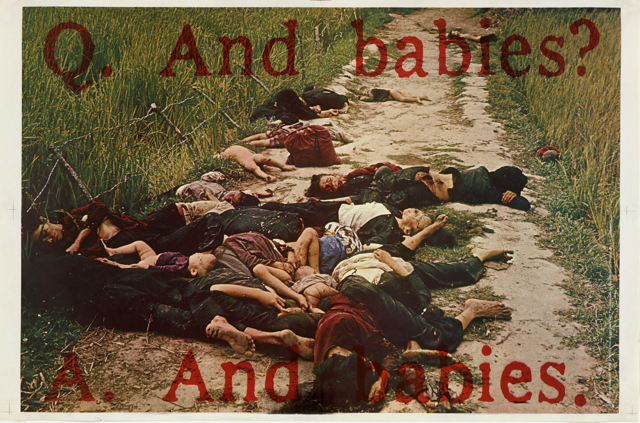… The bitterest quarrel the
Art Workers Coalition has had with the museum [
The Museum of Modern Art] was over joint sponsorship of the
Song-My [My Lai] massacre protest
poster—a ghastly colored photograph of the event by a
Life photographer [Ronald L. Haeberle] captioned
'Q: AND BABIES? A: AND BABIES', which was vetoed by the
president of the Board of Trustees [David Rockefeller] after an initial, though unexpected, executive staff acceptance of the proposal. We picketed and protested in front of
Guernica, published 50,000
posters on our own and distributed them, free, via an informal network of artists and movement people; it has turned up all over the world. Our release read, in part: 'Practically, the outcome is as planned: an artist-sponsored
posters protesting the
Song-My [My Lai] massacre will receive vast distribution. But the Museum's unprecedented decision to make known, as an institution, its commitment to humanity, has been denied it. Such lack of resolution casts doubts on the strength of the Museum's commitment to art itself, and can only be seen as bitter confirmation of this institution's decadence and/or impotence.’
Via this and other experiences we discovered that semi-private institutions are unable to buck their trustees, particularly when the issue is one that presents the trustees with a direct conflict of interest. (As
Gregory Battcock said at the
Open Hearing: 'The trustees of the museums direct NBC and CBS, The New York Times and the Associated Press, and that greatest cultural travesty of modern times—The Lincoln Center. They own AT&T, Ford, General Motors, the great multi-billion dollar foundations,
Columbia University, Alcoa, Minnesota Mining,
United Fruit and AMK, besides sitting on the boards of each others' museums. The implications of these facts are enormous. Do you realize that it is those art-loving, culturally committed trustees of the
Metropolitan and
Modern museums who are waging the war in Vietnam?') We also discovered that one thing museum administrators can't seem to realize is that most of the art workers lead triple (for women, often quadruple) lives: making art, earning a living, political or social action, and maybe domesticity too. When the museum official gets fretful about our distrust of long dialogues and our general inefficiency irresponsibility, he calls it), he forgets that he is being paid a salary for 'caring for' work and issues that his opposite number on the picket line produces in return for no financial assurances whatsoever and that the Coalition itself has to beg time from the 'real' world to get anything done at all.
Certainly it is everybody's individual choice as to how he is going to handle his political burden (though anyone so sheltered as to believe he has no such burden is riding for a shock). The AWC will be powerful only in the art field, where artists have power, and it seems to me that if an artist is more involved in the
Peace Movement
than in artists' rights he should be working directly for the movement. What anyone can do via the AWC for the
Panthers or for peace or for Welfare mothers or trees can be done a hundred times better within those organizations specializing in each of those fields. As an artist, however, he can exert his influence on those institutions which depend on him for their life, to make them speak up and influence others. The fact that these institutions are run by people running other areas of the larger world makes artists' actions as artists all the more important. What is sad is how few artists will even acknowledge their political burden, how many seem to feel that art, and thus their own art, is so harmless that it needs no conscience.
At least I don't hear that doubtful statement
'My art is my politics' quite so often since
Art Strike and other recent developments. It's how you give and withhold your art that is political. Your art is only your politics if it is blatantly political art, and most of the people who say that are blatantly opposed to political art. The Coalition is neutral; it has always been a non-aesthetic group involved in ethics rather than aesthetics. (Lenin said ethics was the aesthetics of the future.) For the most part, however, the artist's dilemma: Is this the kind of society I can make art in? What use is art in this or any society? Should it have no use, even morally? remains unsolved in or out of the AWC. …
— excerpt from
Lucy R. Lippard, “The Art Workers’ Coalition: Not a History,” Studio International (London), November 1970 (Vol. 180, No. 927), pp. 173-4. [ Edited and reprinted in
Lucy R. Lippard, "Get the Message? A Decade of Art for Social Change," New York : E.P. Dutton, 1984, pp. 10-19. ]
